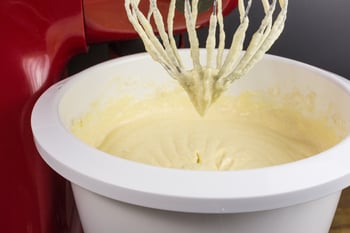
The world’s most popular chicken nugget, McDonald’s Chicken McNugget, was introduced in 1983 and comes in 4 standard shapes: the bell, boot, ball, and bone. Next time you order from the drive-through, take a look in the box and see if you can find all 4 shapes.
Dr. Robert C. Baker, a food science professor at Cornell University in the 1950s, invented the chicken nugget.
This bite-sized piece of chicken, coated in batter and then deep fried, was called the "Chicken Crispie" by Baker and his associates. Earlier attempts had failed because the meat industry could not find a way to hold the ground meat together without skin. Another issue was producing a batter that would not come off of the ground meat while frozen or deep fried. Dr. Baker was able to solve these challenges and made it possible to form chicken nuggets into any shape. He first coated the meat in vinegar, salt, grains, and milk powder, which held the meat together. Then Dr. Baker used an egg to apply a grain-based batter, which was able to be fried and frozen without coming off of the chicken nugget.
The process of preparing the chicken nugget for batter varies. Some chicken nuggets are formed using ground meat, some are cut into proper proportions, etc. What we will be covering here is the actual process of battering and frying the formed chicken nugget.
Whether you prefer McDonald’s or Chick-fil-A, it’s safe to say everyone has their particular favorite. No matter which nugget you choose, they are all made using a similar process as below.
Commercial manufacturers follow Hazard Analysis Critical Control Point (HACCP) guidelines to ensure food safety. The FDA says, “HACCP is a management system in which food safety is addressed through the analysis and control of biological, chemical, and physical hazards from raw material production, procurement, and handling, to manufacturing, distribution, and consumption of the finished product.”
The original equipment used a separate machine for each step to duplicate the hand operation. These days, modern equipment is fully automated, producing thousands of identical nuggets per hour without any human contact.

After the chicken nugget is formed to the desired shape and weight, it is then sent through the pre-dusting, battering, breading, and frying processes.
Pre-dusting is the process of covering the chicken nugget with a fine coating of flour or bread crumbs. Factors that determine whether this step is needed include the wetness of the surface, the extracted proteins on the surface, and the availability of equipment. The pre-dust adheres to the surface of the chicken nugget by absorbing free water on the surface. The chicken nugget surface must be prepared before going through this process to ensure the pre-dusting coating adheres. This preparation acts as a binding between the chicken nugget and the batter.. Elements such as the temperature of the meat and the amount of free water on the surface must be addressed by supplementing the dry pre-dust mix with proteins or by extracting the meat proteins to the surface of the product.
Battering is the process of using a wet product to coat the chicken nugget. There are three main types of batters:
- Adhesion batters are designed to attach to the meat product. Usually starched-based with high solid content and low viscosity. These batters are used when you are going to be adding a breading layer. Because it is a thin coat it dries quickly and evenly, providing a good support layer for the breading. The application of this batter is usually done on a continuous moving line using an overflow of batter.
- Cohesion batters are designed to form a shell around the product. Typically flour-based and used to form an envelope around the chicken nugget and as a base for ‘cementing’ the next breading layer. Since this batter is thicker it takes longer to dry.
- Tempura batters are usually not supplemented with breading and are used to create a puffed layer around the product. Similar to cohesion batters with a large number of leavening agents (ingredients that make a dough or batter rise). These batters are used as an outer coating and are commonly not supplemented with breading. This batter is normally not used on chicken nuggets.

Each batter has a different viscosity or thickness. A fast and inexpensive way to measure the viscosity is to use the Zahn/Stein cup method-using a funnel to determine the amount of time it takes for the batter to flow through the narrow opening.

Some typical time values are:
- Adhesion batter – 9 to 12 seconds
- Cohesion batter – 28 to 30 seconds
- Tempura batter – 45 seconds
Overall, most manufacturers purchase dry, pre-mixed batters from an ingredient supplier and store them in a dry area to eliminate moisture absorption.
Creating an even layer of the batter is essential and easy to achieve when coating chicken nuggets as they are usually uniform in size and shape. Adhesion and cohesion batters are pumped from a container or directly from the mixer into a trough which overflows and cascades, coating the product from the top. You can imagine a fountain of batter cascading down over the nuggets. Later, the product is dipped into a tub-like cavity and coated from underneath.
Breading is the process done after the batter application and is used to create a unique appearance and texture as well as increase the volume and weight of the product. There are four main types of breading:
- Flour is the simplest form and is commonly used for a full-fry product.
- Home-style or American bread crumbs give the chicken nugget a distinct crust and create a medium to high brown color during the frying operation.
- Traditional/cracker-type crumbs are usually white or colored bread crumbs and, because they are inexpensive, are considered by some to be commodity items. This crumb can be used for full-fry or heated chicken nuggets.
- Japanese-style crumbs, sometimes called “Panko,” are more of a specialty crumb. They normally require special equipment and are the most expensive crumb to use. Unless your product can justify the additional cost, they will not be used in most chicken nugget breading.

After the chicken nugget is battered, it is then transferred to the breading application process on a wire mesh conveyor belt where it lands on a layer of dry breading while more breading is sprinkled from the top.
Frying is done for several reasons. First, to ensure the soft coating will stay on the chicken nugget, second, to develop a brown/gold color on the surface, and third, to cook the meat and non-meat ingredients.
There are different oils/fats commonly used, which can be divided into two categories: vegetable and animal fats. The type of oil or fat chosen depends upon cost, consumer demands, stability, and flavor.
Typically the oil is heated to a maximum of 350°F. The amount of oil each nugget absorbs depends on the length of time the chicken nugget is in the fryer and the type of oil, batter, and breading used.
There is a trade-off between oil temperature and chicken nugget quality. At a lower temperature, more oil is absorbed by the chicken nugget, and at a higher temperature, the oil will deteriorate faster. Some manufacturers will par-fry the chicken nugget and then have it go through a hot air spiral oven to complete the cooking process.
After the chicken nugget has been either fully cooked or par-fried it is then usually frozen before being packed and shipped to the consumer.

If a chicken nugget is only par-fried then it will need to be fully cooked by the consumer. If it is fully cooked, then it will only need to be reheated.
When you’re in line at the drive-through or sitting at a restaurant, or even opening that bag of Dino Buddies chicken nuggets at home – now you know what’s involved in getting them ready to go!
And did you know that Dixon has equipment that is used in the production of chicken nuggets? We have fittings, valves, and pumps. Our BC/BP sanitary centrifugal pumps can be equipped with a hot oil stub shaft that can handle up to 350°F hot oil. Our JRZL positive displacement pumps can be used in the battering process for mixing and recycling the batter after coating using heli-lobe rotors that help keep air entrapment down to a minimum level.
Visit  to learn more about our poultry pumps.
to learn more about our poultry pumps.
Sources:
- https://www.mcdonalds.com/us/en-us/about-our-food/our-food-your-questions/chicken-and-sandwiches.html
- https://en.wikipedia.org/wiki/Chicken_nugget
- https://www.honey.com/honey-industry/regulation/haccp-definition-and-procedures
- http://download.poultryandmeatprocessing.com/v01/SciPoultryAndMeatProcessing%20-%20Barbut%20-%2014%20Battering%20%26%20Breading%20-%20v01.pdf


